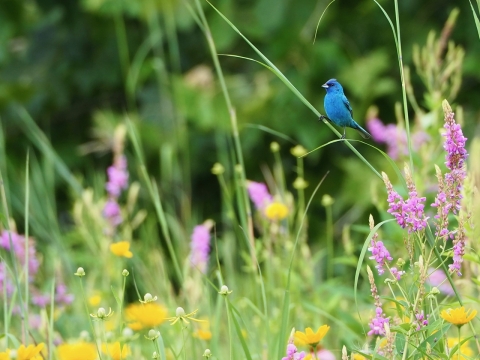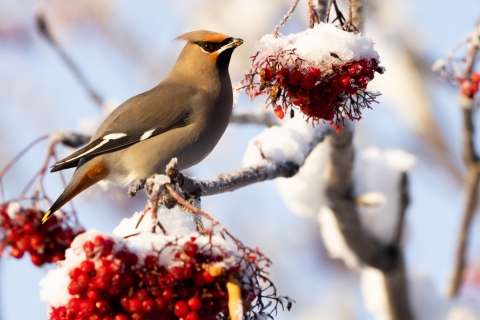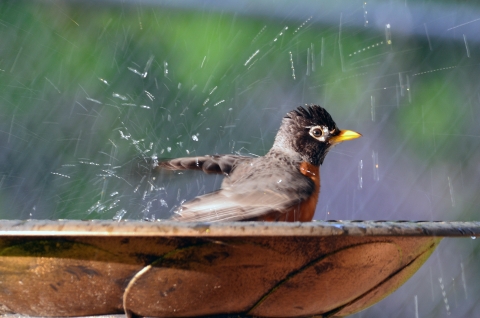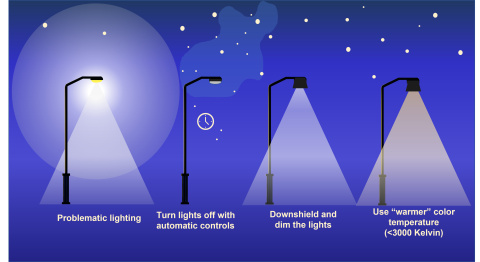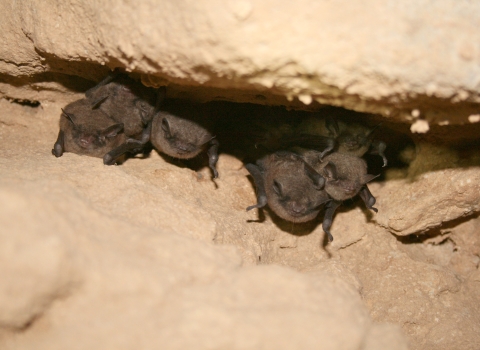With just a few thoughtful changes, each of us can help transform our outdoor spaces into safe, nourishing, and inviting homes for feathered visitors. From nesting nooks to bug-rich bushes, native plants to cozy water spots, we hold the power to make life a little easier for birds right where we live. Here’s how you can open your door to nature—starting with a place to nest.
Provide a Place to Nest
Offer a Birdhouse
Visit your local nursery or backyard bird shop to learn about the best birdhouse for your local cavity nesters. Not all birdhouses are the same, so choose the right house for the species you want to attract. Make sure you prevent spreading disease by cleaning your birdhouses each year.
Leave the Leaves, Bushes & Branches
For nest builders, consider planting multiple layers of structure structure
Something temporarily or permanently constructed, built, or placed; and constructed of natural or manufactured parts including, but not limited to, a building, shed, cabin, porch, bridge, walkway, stair steps, sign, landing, platform, dock, rack, fence, telecommunication device, antennae, fish cleaning table, satellite dish/mount, or well head.
Learn more about structure and also letting branches and bushes grow out through the nesting season. In turn you will help bugs like worms and centipedes, and amphibians like frogs and salamanders, stay safe and happy. Birds love eating the many bugs that live in the leaves!
Provide Food Resources
Choose Native Plants
Native plants are specifically evolved and adapted to work in your local ecosystem. Choosing native plants in your garden or landscape can even save you money and effort in the long run. They generally require far less maintenance compared to most non-native plants. Native pollinators, birds and other mammals also rely on the familiar blooms. They can provide food, shelter, and other resources for native wildlife throughout the year. Many local nurseries work in partnership with backyard habitat certification programs to offer you discounts on native plants and often offer guides to help you get started!
Tree Logs & Snags
Trees, both alive and dead, provide some of the best habitat for all kinds of wildlife! Birds and small mammals find shelter inside cavities and bats sleep behind loose bark during the day. Insects, including important pollinators like beetles and bees, build nests in the wood or cavities which, in turn, feed insect eating birds! Oak tree species are known to welcome some of the highest numbers of wildlife species in North America. If well planned and maintained, they can also be a visually pleasing feature in your landscaping.
Keep a ‘Wild’ Zone
There’s no need to mow everything! One of the easiest and most cost-effective ways to create wildlife-friendly habitat is to leave sections of your lawn un-mowed or even transformed into a “wild” zone with native wildflowers. Many species use tall grasses and wildflower plant patches for shelter and to build nests. They would also feast on bugs, berries and nectar of native plants you could replace lawn grass with. “Wild” areas don’t need to be unsightly! Try planting some native grasses or wildflowers, adding a rock border, or, give it some character by placing a sign explaining to passersby how your area is now "Bird-friendly" or "Pollinator Habitat"
Landscape for All Seasons
If you include plants that bloom throughout all seasons in your landscape, you can help provide birds and other wildlife with food year-round! Plant a variety of native berry bushes, trees, grasses and flowers that provide fruits, nectar, seeds, nuts, and beneficial insects throughout the seasons.
Provide Water
Offer a Birdbath
A birdbath provides fresh water to keep birds hydrated and cool during the hot summer months. You can even add some rocks to make it bee-friendly! Help prevent spreading disease by cleaning your birdbath often.
Build a Pond
Create a water feature in your yard to provide a home and drinking water for wildlife. While providing a valuable water source, you will also offer a breeding place for bugs like damselflies, which help control mosquitoes and also are a great food source for bats and birds.
Minimize Dangers
Prevent Collisions
Around a billion birds die each year in the United States from colliding with glass! There are numerous cost-effective methods you can use to make your windows and other glass structures visible to birds to prevent this. Two of the more common methods are to place bird decals on the outside of the glass at least 2 inches by 2 inches apart (to protect even the smallest bird species) or to paint your windows with tempura paint. This can be a fun activity you can do with kids, a class or other people in your community!
Threats to Birds: Collisions with Glass
Reduce Nighttime Lighting
Birds (and all animals) can be negatively impacted by artificial light at night. Lights can steer birds off their path, causing them to deplete their energy stores during migration as they circle the lights or fly off course. They can be drawn closer to danger as they often fly towards lights near glass they may collide with or other threats like predators. By turning off, or minimizing use of lights at night as much as possible, you can make a big difference for birds! If you must have lights at night, you could consider using motion-sensored lights or lights with timers that minimize exposure. It is also best practice to point lights down rather than up towards the sky, and to shield lights to prevent light escape wherever possible. From the inside, it is good to close curtains or blinds at night as well.
Threats to Birds: Nighttime Lighting
Be Mindful of Pets
Outdoor cats and dogs are some of the biggest dangers to native wildlife! Free roaming cats kill billions of species around the world each year, and over 2.4 billion birds per year in the United States alone. Native wildlife can also put your pets in harms way. To protect native wildlife, and your beloved furry friend, keep your pets on a leash to stop them from chasing birds out of their homes (or worse). You could also get or build a structure to keep pets in your yard such as a fence or protected "catio" type structure so they can still roam without harm.

